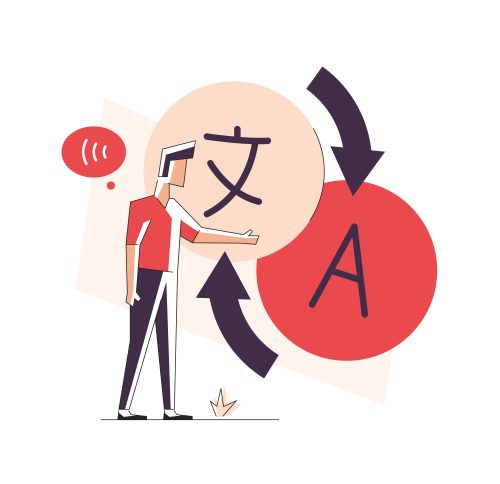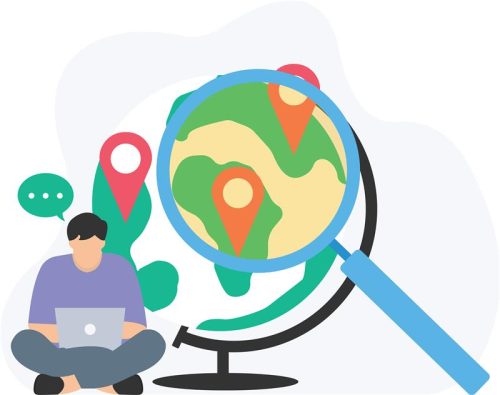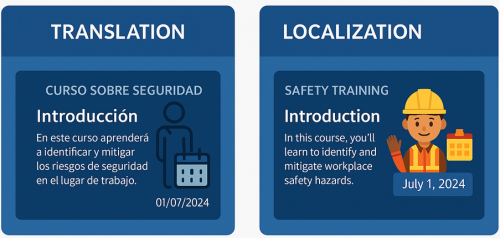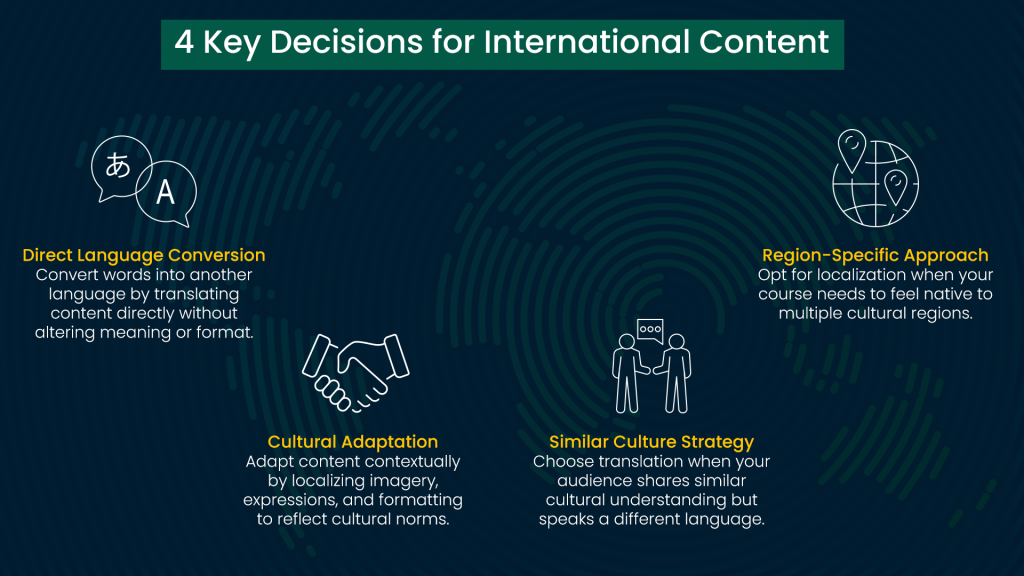Within the globalized world of digital studying, course creators utilizing instruments like Adobe Captivate are sometimes confronted with a necessary resolution: ought to they translate their content material, or ought to they localize it? Though these phrases are ceaselessly used interchangeably, they signify totally different approaches to adapting eLearning content material for numerous audiences. Understanding this distinction is significant for guaranteeing your programs are efficient, participating, and related to learners—wherever they’re.
Understanding the Fundamentals: Translation vs. Localization
Translation is the easy conversion of textual content from one language into one other. It’s a word-for-word conversion that retains the unique construction and which means however doesn’t think about cultural or contextual nuances. As an illustration, a security coaching module written in English might be translated into French to make the knowledge comprehensible to French-speaking workers. The content material stays unchanged aside from the language.

Localization, alternatively, goes far past language. It includes adapting the course content material to replicate the cultural, regional, and social norms of the audience. This may embody modifying date codecs, altering visible parts (like symbols or colours), changing idiomatic expressions, and even rethinking examples and situations to resonate extra successfully with a particular tradition. For instance, a module on customer support may localize by changing American examples of “the client is at all times proper” with Japanese ideas of “omotenashi” (hospitality), utilizing native names like “Tanaka-san” as an alternative of “Mr. Smith,” and displaying office situations that replicate Japanese enterprise etiquette and bowing customs slightly than handshakes.

Visible idea: A break up picture displaying beneath the identical eLearning slide in two variations—one translated actually with similar imagery and formatting, and the opposite localized with culturally acceptable imagery, regional date codecs, and tailored language tone. This visible comparability successfully illustrates the core distinction between translation and localization at a look.

Adobe Captivate: A Platform Constructed for Each
Adobe Captivate is designed to make your eLearning content material globally accessible by offering strong options that streamline each translation (changing language) and localization (adapting for tradition and context). Right here’s how its core elements play a task:
- Textual content Blocks
- Translation: Textual content blocks are modular and simple to export/import utilizing XLIFF (normal translation recordsdata), enabling fast language substitute with out disturbing format.
- Localization: You possibly can create a number of textual content variations (multi-state objects) throughout the identical course to point out culturally acceptable examples, idioms, or terminology based mostly on the learner’s area.
- Media Blocks (Audio/Video)
- Translation: Captivate’s text-to-speech engine permits you to generate voiceovers in a number of languages with totally different voice choices, saving time and value on handbook recordings.
- Localization: Captivate’s text-to-speech function permits you to localize content material—for instance, changing narration with a voice that displays regional accents or office terminology.
- Interactive Elements (Buttons, Enter area, Radio group, Dropdown, Checkbox)
- Translation: Interactive elements might be simply up to date with translated labels and directions.
- Localization: Their behaviors might be modified to match cultural studying kinds—for instance, some cultures favor extra guided interplay, others favor exploration.
- Customizable Widgets (Flipcards, Tabs, Carousels, Certificates, and so on)
- Translation: Widgets like flipcards can have textual content changed for any language with out impacting the animation or design.
- Localization: These might be styled (shade, symbols, icons) and populated with content material that displays native norms, holidays, or codecs (e.g., date/time).
- Responsive Design
- Translation: Captivate’s responsive design ensures that translated content material—particularly languages with longer textual content strings or distinctive characters—suits seamlessly throughout the format. This adaptability is essential to sustaining readability and consistency throughout totally different display screen sizes.
- Localization: Whether or not adapting visuals, colours, or cultural parts for particular areas, Captivate’s responsive design adjusts layouts routinely to assist localized content material, together with right-to-left languages like Arabic or Hebrew, guaranteeing accessibility and visible stability on any system.
Adobe Captivate’s modular structure and design flexibility make it straightforward to translate language precisely and adapt content material meaningfully for native audiences—all whereas sustaining visible consistency and person expertise throughout units.
When to Select Translation
Translation often is the proper alternative when:
- Your learners communicate totally different languages however share an identical cultural context. For instance, Spanish audio system within the U.S. may solely require translated textual content with out extra cultural modifications.
- You’ve gotten a good deadline or restricted finances. Translation is faster and cheaper in comparison with localization.
- Your content material is extremely technical or procedural. Topics like software program tutorials or compliance coaching typically emphasize accuracy over cultural context.
Utilizing Captivate’s content material blocks and textual content modifying instruments, you may simply swap languages, apply constant formatting, and leverage closed captions or text-to-speech instruments for speedy deployment throughout languages.

When to Select Localization
Localization is right when:
- Your coaching spans a number of nations or areas. A gross sales coaching module supposed to be used in Japan, Germany, and Brazil should really feel native to every viewers.
- Cultural relevance is vital to learner engagement. Matters like customer support, advertising, management, and ethics typically require localized examples and tone.
- You wish to maximize studying outcomes. Programs that resonate emotionally and contextually result in higher retention and utility of data.
Strategic Inquiries to Ask Earlier than Deciding
Earlier than you select between translation and localization, ask your self:
- What are my coaching objectives and who’re my learners? In case your workforce is multilingual however regionally concentrated, translation may suffice. If it spans continents and cultures, localization is probably going required.
- What’s the complexity and sensitivity of the subject material? The extra nuanced the subject, the extra possible it’s going to profit from localization.
- Do I’ve the time and sources for localization? Whereas extra impactful, localization does require upfront planning and funding.
- How necessary is learner engagement and course completion? Localization usually leads to greater engagement, satisfaction, and success charges.
Closing Ideas
Translation is about making your course comprehensible, whereas localization is about making it relatable. When you’re utilizing Adobe Captivate, you’re already geared up with a strong toolkit that helps each methods. Whether or not you go for a fast translation or a completely localized studying journey, aligning your alternative along with your coaching objectives and viewers wants is vital.
By understanding the nuances and leveraging Captivate’s options accordingly, you may create impactful studying experiences that transcend language obstacles and really join along with your learners.


